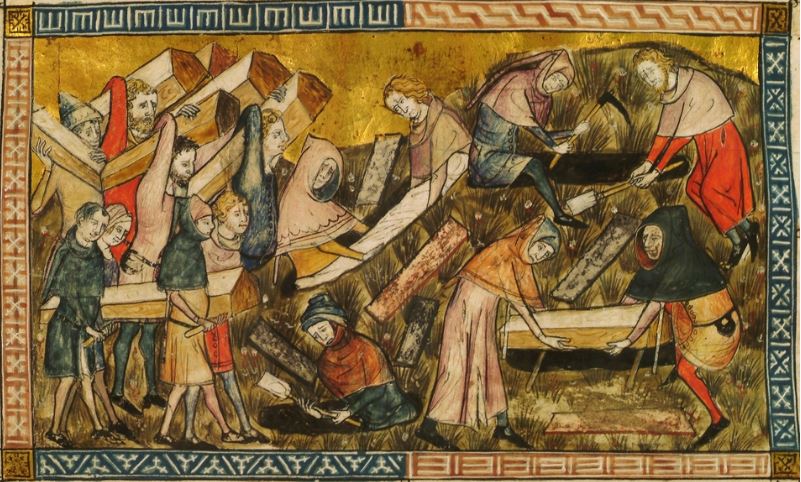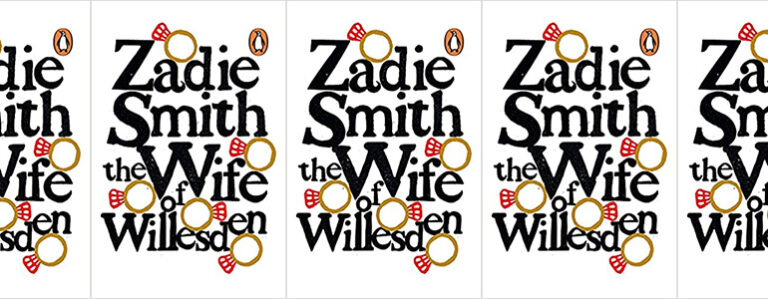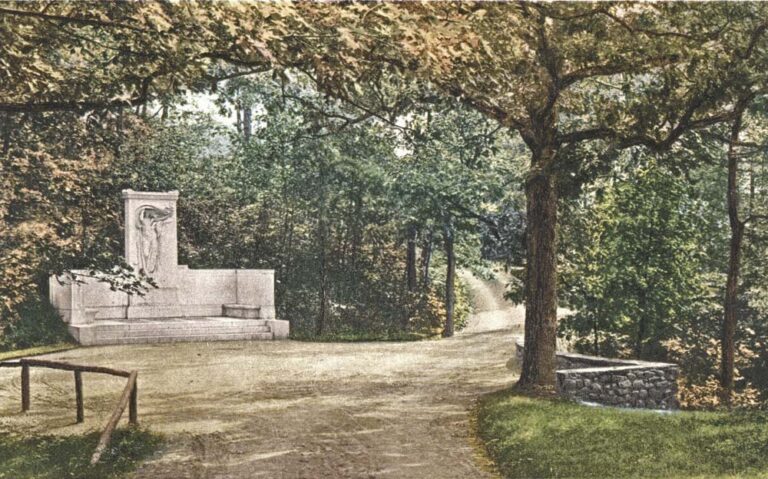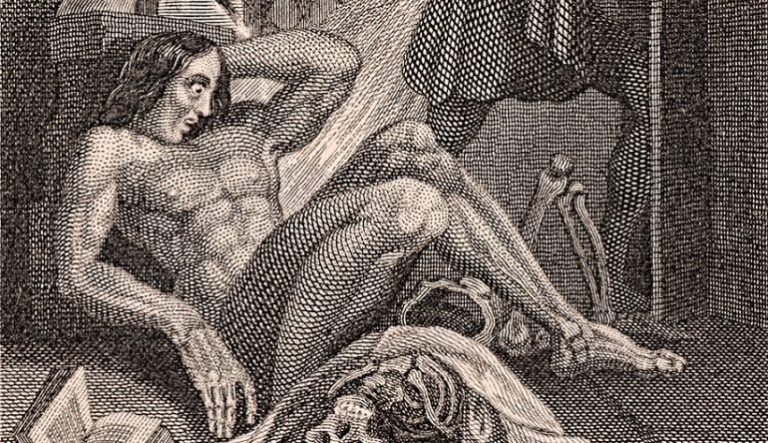Literary Silence in the Time of Pandemic

Pandemic literary history is one of silence. Despite the proliferation of think pieces at the start of the COVID-19 outbreak celebrating a rich past and future pandemic literary history—with a foolishly misguided, neoliberal emphasis on increasing productivity in the midst of trauma to boot—the history of literature from the Black Death to the AIDS epidemic is suffused with gaps.
As COVID-19 spreads uncontrolled, I find myself returning to two wildly disparate texts to consider this record of silence wrought by pandemic: Geoffrey Chaucer’s The Book of the Duchess and J.R.R. Tolkien’s The Hobbit. Both are surprising works to consider here. The Book of the Duchess famously never mentions the plague despite the Black Death causalities that permeate the poem, and The Hobbit likely only reads as epidemic silence to me because of my experience with it during the AIDS crisis. But both speak to an important, though less tangible, history of quarantine literatures. Such a history is a record of mourning. It’s a record of all the things that cannot be spoken while living with upheaval and grief.
Written in the latter half of the fourteenth century, sometime between the years 1368 and 1372, Chaucer’s The Book of the Duchess is a frustratingly elusive text. It’s especially challenging for us as modern readers in part because of its genre: the dream vision. A wildly popular form of medieval writing, in dream visions multiple narratives occupy allegorically dense dreamscapes populated by talking animals, fantastic settings, and surreal encounters. The Book of the Duchess, however, would likely have been challenging for medieval readers as well, as Chaucer layers multiple frame narratives precariously one on top of another. In the outermost layer, the dreamer, still awake, describes his multi-year insomnia; in the next, he recounts a story from Ovid about the death of Ceyx and the mourning of Alcyone; in the next, the dreamer enters the dream, where he encounters chapels decorated with scenes from The Aeneid and a hunting party. Finally, the dreamer meets a mysterious knight dressed all in black and deep in mourning.
It is the dreamer’s encounter with the Black Knight that occupies much of the poem and that lies at the heart of the narrative. The dreamer, attempting to follow the hunting party, accidentally stumbles on the knight reciting a poem about loss that is so effecting the dreamer, appalled, marvels, “[It] was great wonder that Nature / Myght suffre any creature / To have such [sorrow] and be not ded.” Moved by pity, the dreamer asks about the source of the knight’s pain. This leads the Black Knight to offer a series of oblique explanations, alternating descriptions of losing chess games against the wily Lady Fortune with detailed discussions of the beauty and charm of his lover, a mysterious lady known only as White. Over the course of his explanation, it becomes increasingly obvious that White has died. Indeed, he indicates as much from the very beginning of his lament: “I have of [sorrow] so great [abundance] / That joye [get] I never non, / Now that I see my lady bryght, / Which I have loved with al my myght, / Is [from] me ded and ys [gone].”
And yet, maddeningly, over the course of nearly one thousand lines of poetry and through an intensive interrogation process, the dreamer doesn’t understand. What, he wants to know, has happened to throw the Black Knight into such deep mourning? He seems to have missed entirely the knight’s initial explanations, and the dreamer’s increasing requests for clarification so miss the mark that the Black Knight twice laments: “Thou [understand] ful [little] what thou [means]; / I have lost more than thow [suppose].” The tensions between the two build with the Black Knight trying to explain, the dreamer trying and failing to understand, and the reader knowing the true source of the knight’s grief. Until, finally, after baldly stating that it is White he has lost, the dreamer and the Black Knight have the following exchange:
‘Allas, sir, how? What may that be?’ Alas, sir, how? What loss may that be?
‘She ys ded!’ ‘Nay!’ ‘Yis, by my trouthe!’ She is dead! Nay! Yes, by my honor!
‘Is that youre los? Be God, hit ys routhe!’ Is that your loss? By God, it is pitiable!
After this, the knight and dreamer speak no more. Jarringly, the long-forgotten hunt returns and the dreamer suddenly awakens to write down the entirety of this “so queynt a [dream].” The ending is abrupt, almost shockingly so. After spending over a thousand lines in a richly detailed dream-world, and in the aftermath of an intensive excavation of the knight’s grief, the poem is stripped of description, shutters all talk of mourning, and leaves us and the knight with no consolation other than the mild, “Is that youre los? Be God, hyt ys routhe!”
The end of the poem, characteristic of Chaucer’s tendency to refuse neat, satisfying endings—really, any endings at all—resonates with silence. In the face of the brutal acknowledgment of the knight’s loss, there is nothing left to see in the dream, nothing left to say. It resides forever in that painful moment, one that anyone who has ever tried to offer consolation can recognize, of quiet, anxious agony, realizing that there is nothing more to say or do in the face of another’s pain.
What makes the abrupt cessation at the end of The Book of the Duchess all the more resonant is the Black Death history it gestures to, but elides. A history of real loss captured in the haunting identification: White.
*
The first time I heard the word faggot I was eight. I was struggling through my first reading of The Hobbit, and the eponymous hobbit, Bilbo, and his dwarven and wizardly compatriots had just reached shelter in the land of the elves, Rivendell. The elves, seemingly overjoyed by the company, welcomed them singing: “O! what are you seeking, / And where are you making? / The faggots are reeking, / The bannocks are baking!” I’d never heard of either faggots or bannocks before, so I asked my parents what these words meant. When my mother—shocked—informed me that the former was a word for men who like other men, I must have made a confused face because my dad quickly clarified that it also meant a bundle of sticks.
The entire exchange feels ironic now: perhaps the only time in my life where the straight reading has made more contextual sense than the queer. (And it’s certainly much more charming than the first time I heard the word queer yelled on the playground or the time ten years later when a drunken frat boy called me a dyke and I hid, panting, panicking—how had he known). Looking back, though, perhaps my mother had been primed to a queer reading because of the book’s source, my parent’s friend, Mark.
Mark was a gay man, tall, thin, prematurely balding with a fantastic capacity for talking to children as if they were adults. He had just returned to rural Alabama from the Northeast, purportedly to take care of his mother. We’d see him about once a month when he’d give me a small stack of books. By the time I read it, The Hobbit was only one of many: The True Confessions of Charlotte Doyle (which I loved), Great Expectations (which I hated), Redwall (which I still have on my nightstand). The Hobbit was special for a number of reasons, partly because it was the most challenging thing I’d read up to that point, but primarily because of the advice Mark gave me about reading it. It’s advice I still stand behind: 1) Don’t give up during the long passages of exposition, 2) Pretend Bilbo’s a girl—it’s better that way, and 3) Remember it’s a story about exile.
Books were the primary way Mark and I communicated. He never talked down to me or lectured, something that I, a too-smart, too-eager kid, deeply appreciated. But, in a way that resonates deeply with the literature professor I’ve become, he gave me books to help me think beyond the boundaries of the small, rural, southern space I occupied, and he’d always have time to talk to me about what I read: my predictable complaints about lengthy descriptive passages, my love of the dwarves, my fascination with elven elitism. What we never talked about was the real reason Mark had come back home. He was dying.
*
The plague arrived in England in June 1348, docking in the trade towns along the South Coast. By that time, it had overwhelmed broad swaths of Eurasia. Traditional narratives date the start of the plague to the mid-1340s and locate its spread along the so-called “Silk Road” trade routes connecting Eurasia and Africa, but recent scholarship has widened the scope even further, dating the outbreak to as early as the 13th century and tying its spread to the colonizing efforts of the Mongols. Known at the time as simply “the death” or “the great pestilence,” the Black Death killed 40% or more of the population of Eurasia and wiped out entire villages. Victims were stricken with large painful swellings as large as apples or eggs, as well as boils, painful black spots, and a terrible, overpowering stench. Death usually occurred in less than three days as the ill grew weaker. Highly contagious, it quickly swept through southern England, reaching London in the winter months of 1348-49 before overtaking the whole of the country. A haunting piece of graffiti, carved into the walls of St. Mary’s church in the small village of Ashwell highlights the incredible loss and devastation left in the plague’s wake: “deplorable, ferocious, violent . . . [only] the wretched survivors remain to witness.” The plague would periodically recur in England for the next several hundred years.
Blanche, Duchess of Lancaster, almost certainly died of the Black Death. Born around 1341, details of her life are sparse and the limited records that remain are filled with inaccuracies and inconsistencies despite the fact that her husband, John of Gaunt, became the most powerful man in England during the reign of his nephew Richard II. She died September 12, 1368, at Tutbury Castle in Staffordshire during one of many resurgences of the Black Death, just as her father had in 1361, as had her only sibling, Maud, in 1362. Her husband was in France at the time, but every year for the rest of his life, Gaunt held a commemoration of her death and was eventually buried beside her. Evidence suggests that The Book of the Duchess itself was written in her honor, including later descriptions of the text as such by Chaucer himself, as well as several small internal references buried within: allusions to a saint John, punning plays on Gaunt’s various titles, and, most tellingly, the references to the lost lady as White, an anglicized version of Blanche’s name.
No direct references to the Black Death or Blanche herself are ever made—everything must be inferred—and even these inferences lie beneath the formally complex layers of the dream vision. Presumably such references, slight as they are, would have been more obvious to the original readers, including John of Gaunt, if he commissioned it, and Chaucer’s literary circle of friends. When coupled with the silence of the poem’s end, however, the haunting play of elision and reference, speech and silence, attests to a complex relationship between what can and cannot be said in the midst of pandemic.
*
Piecing together Mark’s history retrospectively is almost impossible for me, complicated by all the ways queerness is and isn’t spoken of in the white, rural, southern community we’re both from. Less so now, but 25 years ago, talk of queerness was typically approached through implication and metaphor: he loved his mother too much. They’re very friendly. She’s always been athletic. Here are the facts I know: Mark contracted HIV in the late ’80s, and it progressed to AIDS shortly before he returned to Alabama. He died of complications related to PCP (Pneumocystis carinii pneumonia) in 1998. I can’t remember being told about HIV/AIDS, or queerness for that matter. While I know my parents must have explained Mark’s illness because I vividly remembering knowing why Mark could never come over if one of the family had been sick and why he seemed to grow frailer, I don’t remember the explanation itself. Perhaps the possibility of death didn’t feel real. No one I loved had died yet.
I don’t know why he left the Northeast to come back to Alabama, although I have my suspicions. The AIDS epidemic devastated queer communities, wiping out entire generations. Living with that must have been devastating then—living with the absence is devastating now. And, of course, there’s The Hobbit. “What are you seeking? / And where are you making,” the elves ask Bilbo and his companions. The answer is that they are on a desperate, violent quest for a long-lost home. Mark and I didn’t talk about his own return, just as we didn’t discuss the fact that he got weaker as the months went on. Instead, we spoke through literature, the exchange of texts that simultaneously covered over and bridged all that was unspoken between us. Even now, 25 years later, it feels like my first—and best—lesson in grief and the silences that shape it.
*
Despite living and writing through the onset of the Black Death, Chaucer references it only obliquely and very rarely. In the most famous example, a young boy in The Pardoner’s Tale, describes how the “[stealthy] theef men [call] Deeth” roams through the country and has “a thousand slayn [during] this pestilence.” In The Book of the Duchess, where we might expect at least a passing reference, Chaucer is silent, conspicuously so. The most concrete description of White’s death is an entirely allegorical account of her loss during a chess match with Fortune. Chaucer cloaks the narrative in allusions that almost—but never quite—talk about the Black Death. Large elements of Chaucer’s poem are pulled directly from Guillaume de Machaut’s 1349 Judgement dou Roy de Navarre, a text that describes in detail “the horrifying wonders, greater than any others that one can recall” of the Black Death; and yet, Chaucer’s borrowings from Machaut are used to describe love and loss, not the plague. The picture that emerges is of an encounter with pandemic that is strangely muffled, wrapped in formal technique, and obscured from view.
When paired with the final, resonant silence of the poem’s conclusion, this strange muffling speaks to the reality of artistic production during a pandemic. The nature of trauma is such that there is much that is unutterable:
‘Allas, sir, how? What may that be?’ Alas, sir, how? What loss may that be?
‘She ys ded!’ ‘Nay!’ ‘Yis, by my trouthe!’ She is dead! Nay! Yes, by my honor!
‘Is that youre los? Be God, hit ys routhe!’ Is that your loss? By God, it is pitiable!
The Book of the Duchess doesn’t show us a great work produced by the tragic losses associated with pandemic. If anything, the abrupt end of the dream, the haunting references to White, the failure of speech to offer consolation at the poem’s end, reveal the limits of art in speaking about and across trauma. When I say that Mark offered my first and best lesson in grief, I mean that he taught me that silence is essential to grief—that mourning is living with silence.
Chaucer is often characterized as being chronically unable or unwilling to complete an artistic work, to offer a satisfying end. But in The Book of the Duchess this is a deliberate denial. A mirror of the grief it describes, the poem leaves us with silence. Like the wretched survivors of the plague immortalized in the walls of St. Mary’s, we are left to witness and learn to live with the haunting presence of loss.
When Mark died, I wasn’t there. And the past twenty years have required learning how to live with the silence left in his wake. When I open my copy of The Hobbit, it feels like returning to an old conversation. It feels like remembering and speaking back to the past. But I’m critically aware that the person at the other end of the conversation isn’t there. And I am living with the scattered parts of our conversation, conducted through pieces of literature, and am left to learn how to live with that silence.
This piece was originally published on June 22, 2020.


